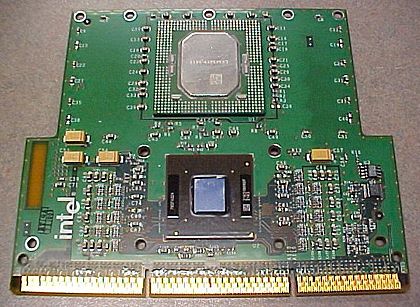Xeon facts for kids
| [[file:Intel Xeon 2020 logo.svg|]]
Logo since 2020
|
|
| Produced | June 1998 |
|---|---|
| Marketed by | Intel |
| Designed by | Intel |
| Common manufacturer(s) |
|
| Max. CPU clock rate | 0.4 GHz to 4.80 GHz |
| FSB speeds | 0.1 GHz to 8.0 GT/s |
| Instruction set | IA-32, x86-64 |
| Microarchitecture |
|
| Cores | Up to 56 |
| Predecessor | Pentium Pro |
| Socket(s) |
|
Xeon is a special type of microprocessor, which is like the brain of a computer. These powerful chips are made by a company called Intel. The first Xeon processor came out in 1998.
Xeon processors are often chosen by people who need very powerful computers. This includes video editors and other "power users." They like Xeons because these chips can have many "cores," which are like mini-brains working together. This gives them a lot of computing power for their price.
Contents
What is a Xeon Processor?
A Xeon processor is a computer chip designed for heavy-duty tasks. Unlike the chips in most home computers, Xeons are built for servers and workstations. Servers are powerful computers that store websites and online services. Workstations are high-end computers used for professional work like video editing or scientific research.
Xeon chips are known for their ability to handle many tasks at once. They can also work with large amounts of memory. This makes them perfect for jobs that need a lot of processing power and reliability.
A Brief History of Xeon
The Xeon brand has been around for many years. It has changed and improved a lot over time.
Early Xeon Chips
The very first Xeon chip was called the Pentium II Xeon. It was released in 1998. This chip was made to replace an older Intel chip called the Pentium Pro in servers.
In 1999, the Pentium II Xeon was replaced by the Pentium III Xeon. A few years later, around 2001, Intel dropped "Pentium" from the name. From then on, the chips were just called "Xeon."
Multi-Core Power
In 2005, Intel released the first Xeon chip with two "cores." This meant it had two mini-brains working together. This chip was called Paxville DP.
Later, in 2007, Intel introduced Xeon chips with four cores. These were part of the Xeon 3200-series. Having more cores helps computers do many things at the same time even faster.
Where Are Xeons Used?
Today, Xeon processors are very important in the world of technology. They are used in many places where strong, reliable computing is needed.
Xeon chips are commonly found in cloud computing systems. Cloud computing means using a network of remote servers hosted on the internet to store, manage, and process data. They are also used in "enterprise-grade servers." These are the big, powerful computers that run websites, online games, and other internet services for large companies.
Powering Supercomputers
Xeon processors are also a big part of the world's fastest computers, known as supercomputers. By 2013, over 80% of the top 500 supercomputers used Xeon chips.
For the very fastest supercomputers, special parts called "compute accelerators" are used. Intel made its own accelerator called the Xeon Phi. The first supercomputers using Xeon Phi appeared in 2012. By 2013, the fastest computer in the world was using it. Xeon-based systems are also known for how quickly they can move data in their memory.
Images for kids
-
Intel Xeon E3-1241 v3 CPU, sitting atop the inside part of its retail box that contains an OEM fan-cooled heatsink
See also
 In Spanish: Intel Xeon para niños
In Spanish: Intel Xeon para niños




